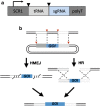Advances and opportunities in gene editing and gene regulation technology for Yarrowia lipolytica
- PMID: 31783869
- PMCID: PMC6884833
- DOI: 10.1186/s12934-019-1259-x
Advances and opportunities in gene editing and gene regulation technology for Yarrowia lipolytica
Abstract
Yarrowia lipolytica has emerged as a biomanufacturing platform for a variety of industrial applications. It has been demonstrated to be a robust cell factory for the production of renewable chemicals and enzymes for fuel, feed, oleochemical, nutraceutical and pharmaceutical applications. Metabolic engineering of this non-conventional yeast started through conventional molecular genetic engineering tools; however, recent advances in gene/genome editing systems, such as CRISPR-Cas9, transposons, and TALENs, has greatly expanded the applications of synthetic biology, metabolic engineering and functional genomics of Y. lipolytica. In this review we summarize the work to develop these tools and their demonstrated uses in engineering Y. lipolytica, discuss important subtleties and challenges to using these tools, and give our perspective on important gaps in gene/genome editing tools in Y. lipolytica.
Keywords: CRISPR–Cas9; Functional genomics; Genetic tools; Genome editing; Metabolic engineering; Synthetic biology; Transposon; Yarrowia lipolytica.
Conflict of interest statement
The authors declare that they have no competing interests.
Figures

Similar articles
-
Synthetic biology tools for engineering Yarrowia lipolytica.Biotechnol Adv. 2018 Dec;36(8):2150-2164. doi: 10.1016/j.biotechadv.2018.10.004. Epub 2018 Oct 11. Biotechnol Adv. 2018. PMID: 30315870 Free PMC article. Review.
-
A review of synthetic biology tools in Yarrowia lipolytica.World J Microbiol Biotechnol. 2023 Mar 22;39(5):129. doi: 10.1007/s11274-023-03557-9. World J Microbiol Biotechnol. 2023. PMID: 36944859 Review.
-
Advances in synthetic biology of oleaginous yeast Yarrowia lipolytica for producing non-native chemicals.Appl Microbiol Biotechnol. 2018 Jul;102(14):5925-5938. doi: 10.1007/s00253-018-9099-x. Epub 2018 May 28. Appl Microbiol Biotechnol. 2018. PMID: 29808327 Review.
-
Genetic Tools for Streamlined and Accelerated Pathway Engineering in Yarrowia lipolytica.Methods Mol Biol. 2019;1927:155-177. doi: 10.1007/978-1-4939-9142-6_11. Methods Mol Biol. 2019. PMID: 30788791
-
Implementing CRISPR-Cas12a for Efficient Genome Editing in Yarrowia lipolytica.Methods Mol Biol. 2021;2307:111-121. doi: 10.1007/978-1-0716-1414-3_7. Methods Mol Biol. 2021. PMID: 33847985
Cited by
-
Engineering Yarrowia lipolytica for the biosynthesis of geraniol.Metab Eng Commun. 2023 Nov 2;17:e00228. doi: 10.1016/j.mec.2023.e00228. eCollection 2023 Dec. Metab Eng Commun. 2023. PMID: 38029016 Free PMC article.
-
Sugar Alcohols and Organic Acids Synthesis in Yarrowia lipolytica: Where Are We?Microorganisms. 2020 Apr 15;8(4):574. doi: 10.3390/microorganisms8040574. Microorganisms. 2020. PMID: 32326622 Free PMC article. Review.
-
Rhodotorula mucilaginosa-alternative sources of natural carotenoids, lipids, and enzymes for industrial use.Heliyon. 2022 Nov 14;8(11):e11505. doi: 10.1016/j.heliyon.2022.e11505. eCollection 2022 Nov. Heliyon. 2022. PMID: 36419653 Free PMC article. Review.
-
Engineering Yarrowia lipolytica to Enhance the Production of Malonic Acid via Malonyl-CoA Pathway at High Titer.Adv Sci (Weinh). 2025 Mar;12(12):e2411665. doi: 10.1002/advs.202411665. Epub 2025 Feb 7. Adv Sci (Weinh). 2025. PMID: 39921326 Free PMC article.
-
Promoters for lipogenesis-specific downregulation in Yarrowia lipolytica.FEMS Yeast Res. 2020 Aug 1;20(5):foaa035. doi: 10.1093/femsyr/foaa035. FEMS Yeast Res. 2020. PMID: 32533836 Free PMC article.
References
Publication types
MeSH terms
Grants and funding
LinkOut - more resources
Full Text Sources
Research Materials

